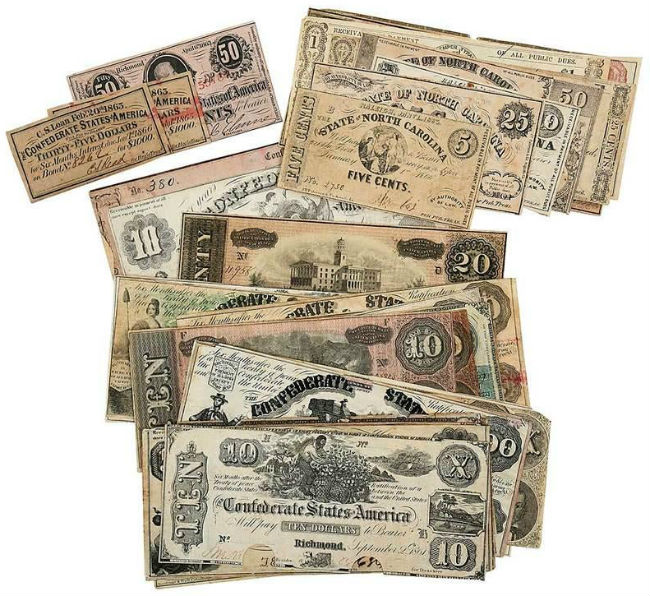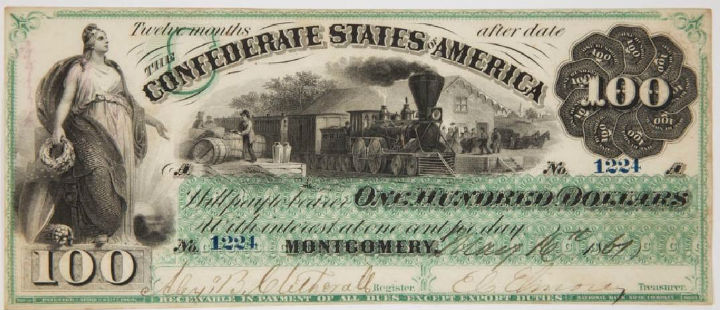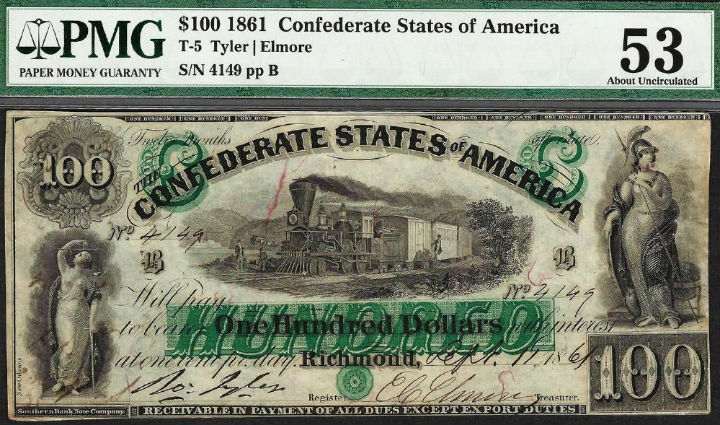
NEW YORK – Scooby Doo fans will remember the classic TV episode, A Night of Fright is No Delight, where the Scooby gang spends the night in a haunted mansion to collect an inheritance from an eccentric millionaire only to find out at the end that the money is Confederate currency and deemed worthless as a medium of exchange. While the show made for good entertainment, they got one key point wrong though. Confederate currency is far from worthless and can bring 50 or 100 times its face value today.
Two months into its existence and just before the outbreak of the Civil War, the Confederate government started printing its own money to be used in the 11 states making up the Confederate States of America (CSA), often referred to as “graybacks” after the color of the Confederate soldiers’ uniforms. Union currency was dubbed “greenbacks.” The first currency banknote printed by the Confederate States of America, first issued into circulation April 1861, amounted to roughly a million dollars worth of money. “Notes were issued for the next three years, ending in 1864,” according to CSAnotes.com.

There were 72 different types of Confederate notes. In nearly all cases, however, these notes were not backed by gold or hard assets, however, only a promise to pay six months after a peace treaty was signed between the North and South. In Mississippi, though, some banknotes were backed by cotton. After news got out that the South was losing the war (after the Battle of Gettysburg), the Confederate government was in shambles and its notes depreciated to the point where they were practically useless as currency and could not be traded for goods or converted into official U.S. currency. Confederate paper money is, however, quite collectible in today’s market, depending on condition and rarity. In general, the earlier years like 1861-62 are more valuable.

Confederate notes are often discernible by their cut. Without benefit of high-quality cutting machinery, Southern banks and officials would hand-sign and hand-cut the notes by hand so many notes have uneven margins. “This means that legitimate Confederate currency should not have perfectly cut edges like you would see on modern currency,” according to the Manhattan Coin Club, which warns people on its website to avoid fakes by paying heed to cut, paper and ink. Also owing to being cash-strapped, the Confederate government used lesser quality paper for printing its notes. Thin rice paper was often used instead of a cotton-linen blend like the U.S. Treasury Department used. In most cases, iron gall ink was used to print CSA notes, which usually turned brown as it oxided and aged. If one sees a Confederate note where the ink is as black as the machine-printed parts of the note, it’s likely a fake. Fakes are prolific today and even during the Civil War, the North issued fake Confederate currency to destabilize the market.

While people are accustomed to official currency today with its standard images and portraits on the verso (George Washington portrait on the $1 bill, Abraham Lincoln on the $5 bill, etc.), the Confederacy used a wide range of motifs and images in its engraving.
The first four notes were issued from the original Confederate capital of Montgomery, Alabama, and they demonstrate a high level of skill in their engraving and printing. “When the Confederate government was moved to Richmond, Virginia, skilled engravers and printers were hard to come by resulting in a lower quality of notes produced,” according to the Paper Money Guaranty website. “The Confederate notes designs mainly showcased Southern themes, including slaves, naval ships, railroads, animals and real historical figures,” the website reads. Mythology symbolism, such as gods and goddesses, and themes unrelated to money were also sometimes used.

Among some of the people portrayed on CSA notes were George Washington, Andrew Jackson and Jefferson Davis. Allegorical scenes or images evincing everyday work scenes were also used. A $50 note from 1861, for instance, depicts two women symbolizing Industry and Agriculture seated on a bale of cotton. At far left is a woman standing and holding the scales of justice and a portrait of Washington at far right. According to Old Currency Values website, this note is thought to be quite rare as less than 5,800 were printed.
The U.S. Civil War era is one of the most desirable periods for currency collectors and Confederate money is certainly among the most colorful and most interesting.
Confederate Currency on LiveAuctioneers
- Collecting confederate money? See Confederate Coins & Currency available for sale
- Sold for $110: Six South Carolina Bank Notes printed by the American Bank Note Company
- Sold for $2,250: The Setauket Bank 1860 $2 Obsolete Note, American Bank Note Company imprint
- Sold for $2,100: 24 About UNC Confederate 1861 $10 Bills, printed by Blanton Duncan, Columbia, SC
- Sold for $2,000: rare red and black note issued by Southern Bank Note Company, with only 14,860 notes issued
- Sold for $900: Notes Issued by The Confederate States of America
- Sold for $180: 5 Confederate $10 Notes with horses pulling cannon center engraving


